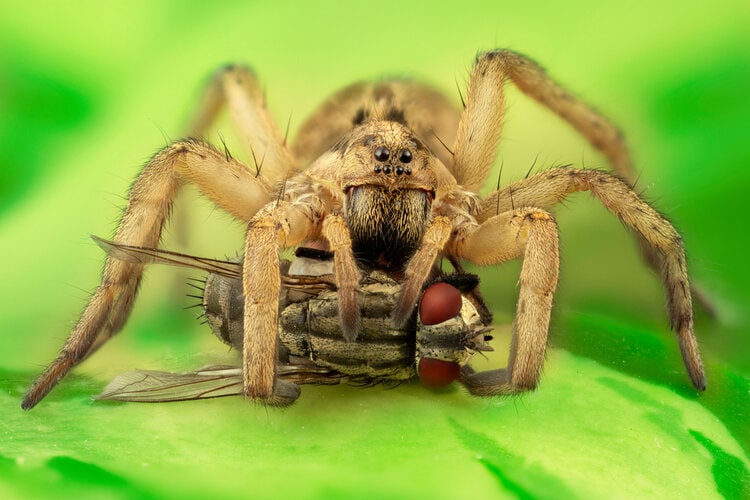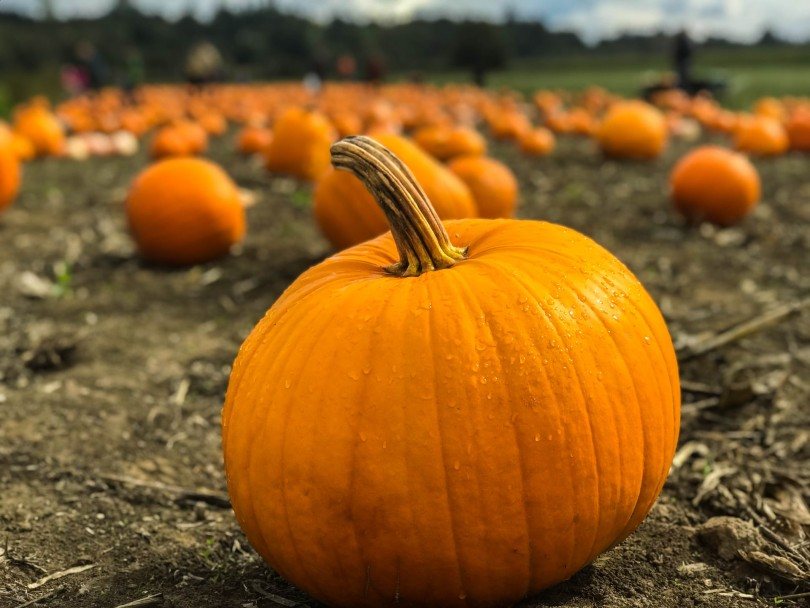Click to Skip Ahead
Wolf spiders acquired their name from the Greek word “Aukoc,” which means “wolf.” But why the term “wolf spider?” It is because they have perfect eyesight, agile hunting capabilities, and the spider’s furry appearance. It is estimated that there are over 2,500 species of wolf spiders. About 125 of these species live in North America.
The spiders can live in a wide range of habitats, except Antarctica. Some species survive on mountaintops, volcanic lava tubes, and rainforests, while others are found in grasslands, desserts, and suburban lawns. The wolf spider’s main diet is small animals they can catch, like crickets, ants, flies, grasshoppers, small invertebrates, and worms, or even tiny birds, frogs, and lizards.
These spiders belong to the Lycosidae family and can grow about ½ inch to 2 inches long. Generally, female wolf spiders are bigger than males. One identifying factor of the females is the egg sac. She carries it by attaching it to the spinnerets found in her abdomen. When her babies are born, she carries them on her back for several days.

What Wolf Spiders Eat in the Wild
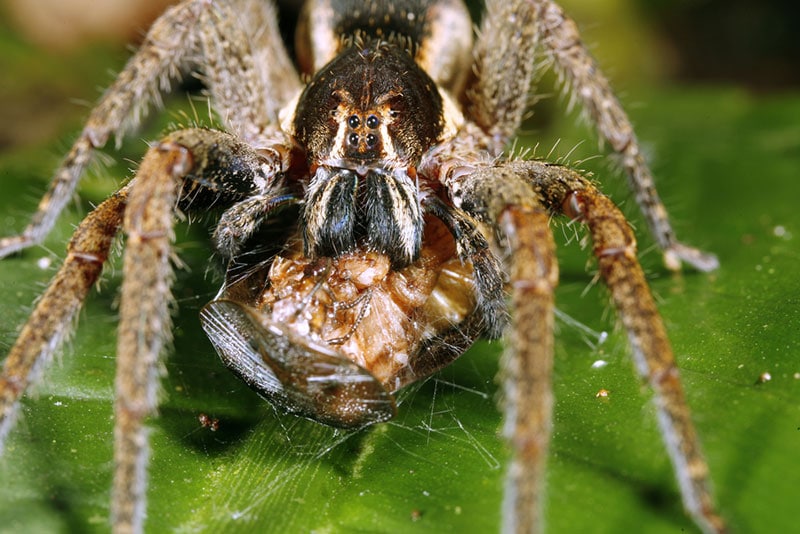
The wolf spider’s main diet is small insects like crickets, ants, flies, grasshoppers, and small invertebrates. Unlike other spiders that build a web to trap prey, they hunt and chase after their meal. Since they are solitary nocturnal creatures, they hunt at night or early in the morning. They use their touch receptors to detect motion. In addition, their excellent eyesight helps in spotting and tracking prey. Then, just like a wolf, they use their long, tapered legs to chase down the meal. The legs give them fast speed and traction.
Some wolf spider species pounce on prey. Once the insect is at hand, they secure it between their legs, and then it rolls over their back to entrap it. Other wolf spiders wait until their meal walks beside them before an ambush.
When wolf spiders catch the insects, they use the long fangs in their mouths to subdue them. It injects venom into its meal, which in turn liquefies its internal organs. This makes it easy for the spider to consume the prey.
What Do Adult Wolf Spiders Eat as Pets?
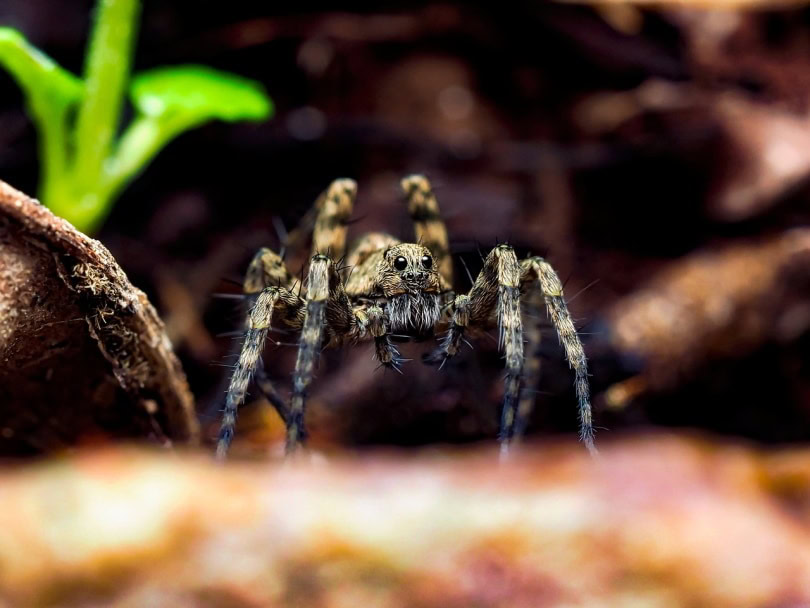
Yes, wolf spiders are good pets for some people. And if you want to own one, you need to know what to feed them.
Wolf spiders eat small insects, worms, and other small-sized spiders. In other words, you can feed them small living animals that they can catch. This also includes tiny birds, frogs, and lizards.
These creatures do not eat much. The rule of the thumb is that you feed them prey that is half their size. Tiny and average-sized wolf spiders feed once every 2 days, while the larger species may need to eat daily. Giant wolf spiders can consume little frogs and lizards.
Since the wolf spider depends on you for its meal, ensure that it is safe. For starters, avoid venomous insects like a centipede or stingers like a bee. You wouldn’t want the prey harming your pet.

What Baby Wolf Spiders Eat
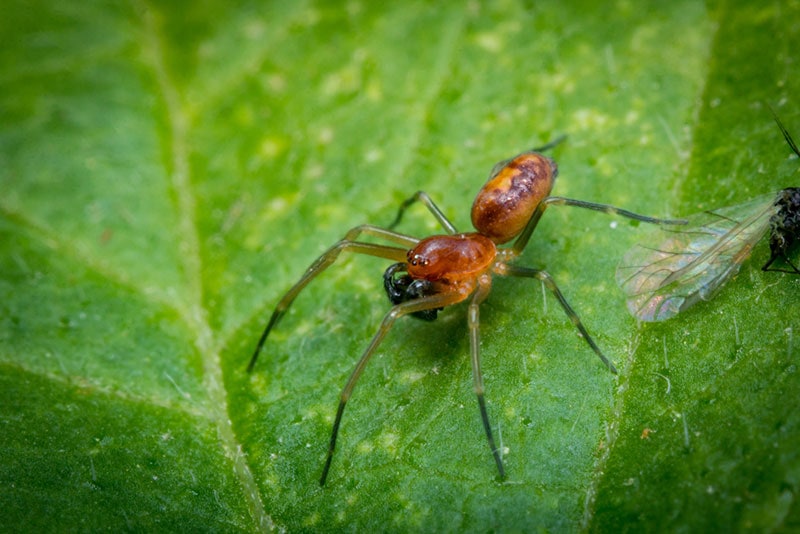
Baby wolf spiders munch on tiny insects or pieces of insects that their mother catches. They mainly depend on their mother for survival for several days. Once they are big and strong, they leave their mother’s back and use the little venom in their system to kill small prey. They do not feed on their live mother like other spider species.
Are Wolf Spiders Dangerous?
Having learned that a wolf spider injects its prey with venom to liquefy the insides, is it a dangerous creature?
No. These spiders only bite humans when they feel threatened. And no, they do not suck human blood. When they bite, their venom is not lethal to humans. However, it can cause uncomfortable symptoms.
If you ever get bit by a wolf spider, follow these five treatment steps:
- Step 1. Clean the wound and treat it with baking soda or ice. You can also rub an antibiotic treatment.
- Step 2. Cover the bit area with a cold towel to reduce pain and swelling. It also prohibits the venom from spreading.
- Step 3. Monitor your symptoms. Take an antihistamine if you have inflammation.
- Step 4. Contact your doctor when you have a high fever, hives, breathing difficulties, swelling in the face, dizziness, or other severe symptoms.
- Step 5. Seek medical attention if you are allergic to bites or have tissue death around the bite area. The pain and swelling can go away in minutes or several days. However, if the symptoms are severe, it is best to consult a doctor.
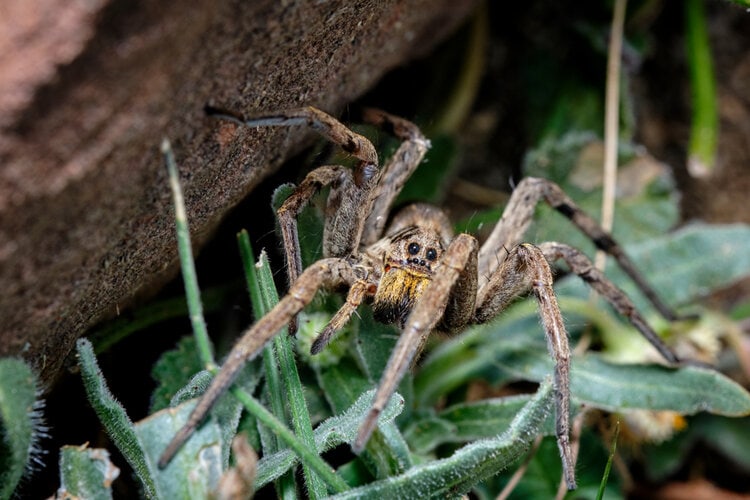
Frequently Asked Questions (FAQ)
Can Wolf Spiders Eat Other Spiders?
Yes, they take advantage and eat what they can find. Wolf spiders do eat smaller spiders.
What Do Wolf Spiders Drink?
They scavenge for water droplets. In addition, they extract fluids from their food sources.
How Often Should You Feed a Wolf Spider?
Most species eat once in 2 days. However, big spiders need to eat every day.

Summary
Wolf spiders can be intimidating to look at. However, these creatures are harmless and only attack when they feel cornered. Their primary diet is insects, worms, and small animals, whether in the wild or at home. They are easy to take care of as pets and don’t demand much.
You may also be interested in:
- 19 Spiders Found in Ohio
- What Do Jumping Spiders Eat in the Wild and as Pets?
- How Do Spiders Find and Communicate with Each Other?
Featured Image Credit: Vida Shams, Shutterstock
